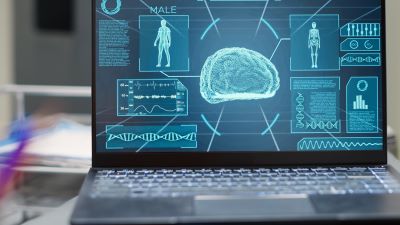AI and big data could revolutionize health care but only if there’s trust in AI models and privacy is protected
 Artificial intelligence combined with big data promises to revolutionize medicine, delivering timely care efficiently to those who need it most while saving on health care costs.
Artificial intelligence combined with big data promises to revolutionize medicine, delivering timely care efficiently to those who need it most while saving on health care costs.
But realizing that promise will require AI models that doctors and patients trust, along with “secure enclaves” where data and privacy are protected, says a health care expert at Microsoft.
 “We can actually apply AI on very large populations, find individuals who have urgent needs to be brought in, and bring them into care in a timely manner,” Dr. David Rhew (photo at right), global chief medical officer and vice-president of healthcare at Microsoft, said at Alberta Innovates’ Inventures conference in Calgary.
“We can actually apply AI on very large populations, find individuals who have urgent needs to be brought in, and bring them into care in a timely manner,” Dr. David Rhew (photo at right), global chief medical officer and vice-president of healthcare at Microsoft, said at Alberta Innovates’ Inventures conference in Calgary.
“Numerous initiatives are underway that will allow us to rethink how care is delivered,” he said.
However, he cautioned: “None of this works unless we have trust” in the AI models and what they can actually deliver.
Canada spends about 15 percent of its GDP on health care, yet health care systems are overburdened and under-resourced.
Health care systems are “bursting at the seams,” said Rhew, adjunct professor at Stanford University School of Medicine. “We don’t have the capacity to be able to do a lot of the things that we’d like to do, such as provide care to individuals anywhere, everywhere at a high level.”
Many people don’t actually come into medical clinics or hospitals, even though they’re at risk of disease, they have a disease but don’t know it, or know they have a disease but don’t realize it has progressed, he said.
AI can be used proactively to quickly analyze large data sets of people and identify those who have urgent health needs so they can be brought to clinics or hospitals and get care in a timely manner, Rhew said.
Another example of artificial intelligence’s use in health care is using AI applied to a retinal image during a routine eye exam, he said. This enables the caregiver to diagnose or identify diseases such as diabetic retinopathy, cardiovascular disease and hypertension, as well as eye conditions like glaucoma and macular degeneration.
Using AI to analyze a retinal image that can be automated and takes about two minutes to obtain can also identify neurovascular conditions, such as multiple sclerosis, Parkinson’s and Alzheimer’s, Rhew said. “It’s extraordinary what can be done through this image.”
The AI-powered technology was used in a remote rural area of East Texas that has few medical services and specialists, and where none of the residents had ever received a retinal scan to check for diabetic neuropathy.
The technology found that one out of five residents screened had some sort of significant disease that required medical attention, Rhew said.
“The problem is the data-acquisition piece and the workflow and the reimbursement [for health care providers] and the alignment [with other care priorities] – getting it into a complex health system,” he said.
However, AI-powered, automated retinal image scanners also can be “put in a box” and located in shopping centres, schools, churches and other public spaces, he added.
“We have to think about new models for [health] care,” Rhew said. “Public-private partnership is going to be one of those new models, and understanding how we can leverage amazing technologies.”
Where could AI be used in health care systems?
AI could lead to faster, more accurate diagnoses, predict the development of disease, support doctors with treatment decisions, and help manage the demand for hospital beds.
Examples of AI use cases in health care, according to clinician-scientists interviewed for an article by health writer Lisa D. Ellis and published by Harvard Medical School, include:
- Automating tasks to free up a clinician’s time to focus more on their patients, “humanizing” care in new ways. Tools like medical scribe technology can automatically capture patient visit notes and store them in a patient’s medical record, flagging key details and insights. This can increase efficiency and free up clinicians to focus more on face-to-face time with their patients.
- Helping clinicians better interpret imaging results. For instance, in gastroenterology, AI can improve the process of getting colonoscopy results, using image recognition to detect and identify polyps on the imaging files. AI can also be used to interpret electrocardiogram and CAT scan results and to identify irregularities. Also, AI can clear those imaging tests with normal results and flag those that need to be reviewed more closely by the experts.
- Helping health care organizations improve quality and safety. One example is using AI software to review a large amount of data quickly and easily to identify people at high risk of developing sepsis. This can enable a health system to respond proactively to try to prevent this problem, such as moving a high-risk patient to a unit with higher acuity staffing. AI can also identify people who have a higher likelihood of developing opioid dependency after surgery to monitor them closely and wean them off the drugs as soon as possible. In addition, AI can be used to identify areas where drug errors are most likely to occur in a health system so the staff can implement stronger safety protocols.
- AI can be an important source of data and expertise for clinicians. In the past, clinicians had to do extensive research to help zero in on a case that was difficult to diagnose or treat. Today, clinicians can ask AI chatbots diagnostic questions and gain immediate access to a wealth of information and advice, saving hours or even days of searching for similar cases.
- Aiding in the diagnosis and treatment of rare diseases. One of the challenges of diagnosing and treating someone with a rare disease has traditionally been that clinicians may not recognize the signs of a condition they have not personally encountered. By scanning large data sets to find similar cases, AI can help clinicians not only get to a diagnosis more quickly but also find examples of treatments that have been effective in people with this condition.
Workforce needs to be trained and empowered to use AI tools
Rhew said another example of AI in health care is the development of AI-enabled electrocardiograms that can predict increased cardiovascular risk and mortality in patients within the next few years.
He noted that Microsoft last month announced it’s testing a new product that “orchestrates” autonomous AI agents for multidisciplinary care teams. The product’s initial framework is designed to study the health care agent orchestrator for assisting tumour boards, a group of multi-specialty oncologists that reviews tumours to determine treatment for patients.
The AI-powered agent orchestrator will help “surface, summarize and take action on relevant multi-model medical information” to decrease the time of tumour board review from hours to minutes, said Dr. Joshua Warner, a radiologist at the University of Wisconsin Health.
The agent orchestrator is in use by cancer teams at Stanford University, Johns Hopkins University, Providence Genomics, Mass General Brigham and the University of Wisconsin School of Medicine and Public Health, according to an article in Fierce Healthcare.
The orchestrator has pre-configured agents, such as a radiology agent, a pathology agent, a cancer staging agent, a clinical guidelines agent and a clinical trials agent.
Rhew said the key to deploying AI effectively in health care is to have data that is organized, well curated, annotated and structured. AI can help “clean” datasets to make them usable.
It’s now possible to collaborate on data without physically transferring or sharing raw data, by using techniques like secure multi-party computation and data clean rooms – moving data into “secure enclaves,” he said.
Rhew pointed to the work by the U.S.-based Alliance for Artificial Intelligence in Healthcare, a multidisciplinary organization aimed at fostering creativity, collaboration and knowledge sharing to drive AI-enabled discovery of novel interventions and product solutions to improve patient outcomes and minimize costs across the entire health care spectrum.
AI technology can be deployed in health care systems initially in “low-risk, high-impact” use cases, such as doing laborious administrative tasks, streamlining workflow and reducing heavy workloads.
But before deploying AI in health care systems, care providers need to identify the type of AI models they can use, test these models on local datasets, and look for bias and other problems, Rhew said.
Most importantly, he noted, “We have to empower our workforce that knows how to use these tools. We have to rethink how we train people into their jobs.”
Canada, with its internationally respected post-secondary education system, can play an important role in this training, Rhew said. “Let’s move away from just building curriculums. Let’s start thinking about how we train individuals on how to use the AI to optimize their clinical performance.”
“If we do that, people will be able to be empowered to use this [AI technology], will have trust in it, and hopefully it will lead to better [patient] outcomes.”
Click here to listen to an interview with Dr. David Rhew by Startup Health.
R$
Events For Leaders in
Science, Tech, Innovation, and Policy
Discuss and learn from those in the know at our virtual and in-person events.
See Upcoming Events
You have 0 free articles remaining.
Don't miss out - start your free trial today.
Start your FREE trial Already a member? Log in
By using this website, you agree to our use of cookies. We use cookies to provide you with a great experience and to help our website run effectively in accordance with our Privacy Policy and Terms of Service.





